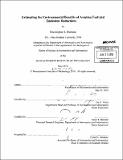Estimating the environmental benefits of aviation fuel and emissions reductions
Author(s)
Dorbian, Christopher S. (Christopher Salvatore)
DownloadFull printable version (11.16Mb)
Other Contributors
Massachusetts Institute of Technology. Dept. of Aeronautics and Astronautics.
Advisor
Ian A. Waitz and James Hileman.
Terms of use
Metadata
Show full item recordAbstract
With commercial aviation continuing to grow and environmental policymaking activity intensifying, it is becoming increasingly necessary to assess the environmental impact of measures that result in changes in aviation fuel bum levels. For estimating air quality and climate impacts, it is important to employ a multi-gas approach that accounts for the effects of all emitted species, not just carbon dioxide (CO₂). The main objective of this thesis is to develop a simplified framework for monetizing the CO₂ and non-CO₂ co-benefits of aviation fuel and emissions reductions. The approach is based on two main pieces, both of which are derived using the Aviation environmental Portfolio Management Tool (APMT). First, the air quality marginal damage cost of a unit of fuel is estimated using an air quality response surface model. Second, a simplified probabilistic impulse response function model for climate is employed to derive a non-CO₂/CO₂ impact ratio that can be multiplied by a social cost of carbon to estimate the additional benefits of fuel bum reductions from aviation beyond those associated with CO2 alone. The sensitivity of the non-CO₂/CO₂ climate ratio to metric choice, scientific assumptions, background scenarios, and other policymaker choices is explored. Notably, it is found that given the large uncertainties in short-lived effects, the choice of metric is not particularly influential on the overall ratio value (that is, similar results-within the range of uncertainty-are found for the different metrics considered). This thesis also validates the use of the climate ratios and air quality marginal damages through two sample applications. The first study explores the impact of various aviation growth scenarios and demonstrates the applicability of this framework to a multi-year analysis. The second study concerns the introduction of an advanced aircraft concept into the present-day aviation fleet and demonstrates the ability of the climate ratios to capture scientific and valuation-based uncertainties. In both cases, the derived ratios and air quality damage costs are found to be a good surrogate for a full impact analysis in APMT, relative to the overall uncertainty in estimating impacts.
Description
Thesis (S.M.)--Massachusetts Institute of Technology, Dept. of Aeronautics and Astronautics, 2010. Cataloged from PDF version of thesis. Includes bibliographical references (p. 99-103).
Date issued
2010Department
Massachusetts Institute of Technology. Department of Aeronautics and AstronauticsPublisher
Massachusetts Institute of Technology
Keywords
Aeronautics and Astronautics.